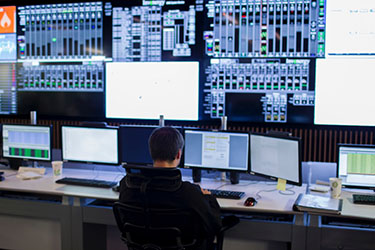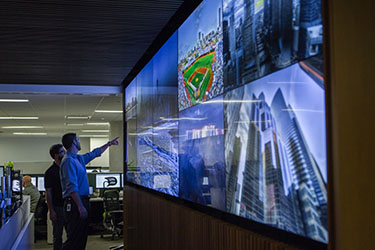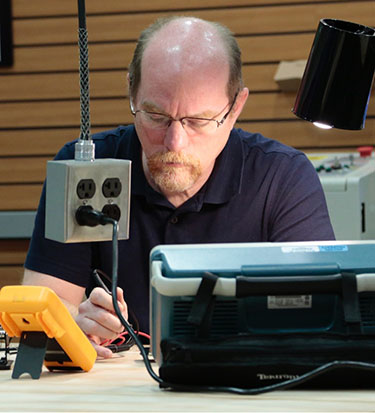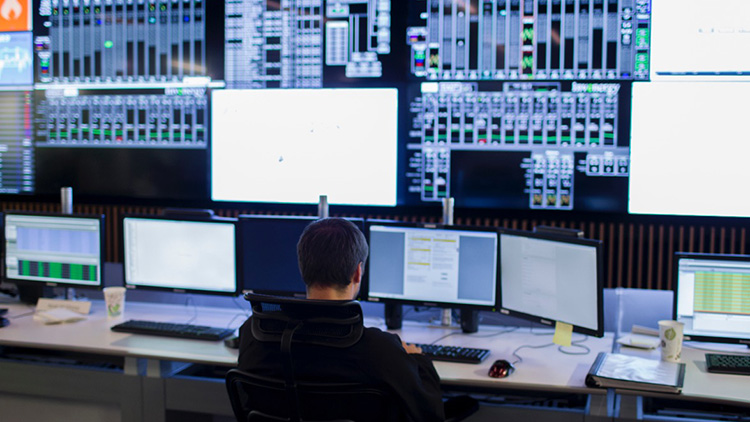Remote monitoring solutions for integrated audiovisual systems enable the proactive diagnostic and access services that IT managers expect. We explore best practices for delivering real-time metrics and alerts to keep your AV systems running smoothly.In 2018, it is no longer “good enough” to have all of your audio and video equipment and systems on the network. AV connected to the network should provide actionable information in real time for immediate troubleshooting, diagnoses, or analysis. If not, then it’s time to take a fresh look at your “monitoring.”

Project photograph courtesy of AVI-SPL
Today, there are thousands of AV devices, appliances, components, and applications that can not only be monitored, but have the capability to provide valuable feedback in real-time. Making the connection even more valuable are the growing number of solutions and services that monitor enterprise-wide AV ecosystems, as well as control and other related systems. Many do so in real-time to provide the C-suite data and information to justify capital expenditures and operational expenses.
Any responsible C-suite executive would insist on defining and identifying business goals before embarking on a project. “There are three primary reasons to collect data from an AV application,” said Paul Zielie, manager of Enterprise Solutions at Harman Professional. He cites verifying performance, improving the design, and discovering new and changing requirements.
Zielie offered the following potential business goals for consideration.

Project photograph courtesy of AVI-SPL
Business Goal: Situational awareness
Service can be strategic—and by monitoring the AV environment to discover failures and proactively correct them before discovered by the user, as well as tracking when preventative maintenance is due. This is the most common use of data collection in the AV industry today.
Prioritize service through context: When there is a failure, analyzing the impact to the operation will allow service resources to be deployed efficiently.
Example: By correlating discovered or reported problems with the schedule, the issues can be addressed in an order to provide the least impact to existing schedules.
Root Cause Analysis: The gathered data history across multiple devices can help service providers pinpoint difficult or previously unknown root causes of overall system behavior problems.
Example: Users may report problems based on their perceptions of where a problem is. A user may report that a display is not working, and analysis may show the input switched to the display does not have video sync on the input. This could lead to a diagnosis of a cable problem on the input.
Determining appropriate asset mix: By collecting data on device usage and meeting attendance, equipment and real estate assets can be deployed appropriately to meet the business goals.
Example: A $100,000 conference room with a large switcher, VTC, two displays etc., is scheduled 100 percent of the time and has a potential demand for 30 percent more use.
Analyzing the data shows that 60 percent of the time, only a laptop, display, and audio conferencing is used, and 80 percent of those meetings have less than five participants.
Without these metrics, the impulse would be to add another identical conference room to supplement the existing conference room.
With these metrics, the customer can confidently determine that a small conference room with $10,000 worth of equipment will accommodate 48 percent of the meetings from the existing conference room and meet the growth needs of the organization.
Increase asset utilization: Analyzing usage data may reveal underused assets that can be redeployed or augmented to increase the return on investment.
Example: A training room is required, but is only used a few days a month. Analyzing data on meeting room use shows that adding a USB room camera and audio conferencing will allow the room to be used for meetings as well.
Business Goal: Improve user experience
A primary goal of any AV application is to meet the needs of the user. One of those needs is to have a simple and pleasant user experience. Analyzing the user’s operation of the system, such as the amount of time required to complete a task or the number of incorrect pages they open on the control system before they take an action can help IT executives understand if the system meets that need.
“If the ultimate goal is to get a better understanding of room-type utilization, then it’s important to understand the amount of time that particular space is in use, as well as how the space is being used,” said Martin Barbour, product manager of Installed Systems at QSC. “This will help you understand why one room type is more popular than another.” In this case you would want to study which source type is used most frequently or how long it takes to get a call or meeting initiated.
“If the overall goal is to reduce downtime and become more proactive from a maintenance perspective, then you may want to focus more on the deep status mining of the various AV assets across your room types, so problems can be identified early,” Barbour added.
Business Goal: Estate Planning
“When it comes time to start diving into business analytics for active monitoring solutions, you need to define the current topology of the estate,” advised Tim Riek, senior VP of Service Operations at AVI-SPL. “The first step is to figure out what you actually have deployed throughout your enterprise. Then if you want it to be capable of offering analytics or being monitored, how accessible are the devices that you’ve deployed and what can you do as a customer or as an enterprise to make those devices more accessible?”
It’s around this point that some put on the breaks. “We speak with a lot of customers who have cobbled together disparate, AV-specific networks to enable some of the wireless interaction of their estates,” said Riek. “Just identifying what they have and where they have it is an overwhelming task for them.”

Frank Pellkofer, Utelogy Corporation
Don’t let the initial site assessment prevent you from making progress. AV/IT firms such as AVI-SPL and others offer services to assess and help evaluate a customer’s estate so it is accessible as a monitoring application. “Certainly, that is a hurdle that a lot of customers have to be able to overcome, and that comes with certifying devices with network security. It comes with a lot of planning, and oftentimes it comes with really making service a design consideration as customers go through technology refresh planning,” added Riek.
Frank Pellkofer, co-founder and CEO of Utelogy Corporation, suggested, “An easy first win is [identifying] the total number of rooms, and see which technology is actually being used.” From there, you can grow into more advanced topics, like the call quality of the video conferencing environment, he said. “We would also want to know if users are gravitating toward room types or technologies that meet their needs. For example, we’d want to answer the question—is Zoom taking off inside my organization, or are our customers continuing to use traditional Cisco and Polycom systems?”
What to Monitor?
Many organizations like to start with monitoring displays, lighting, and conferencing systems. “Most clients actually want to track room usage—such as what spaces are used, how often, how long, and by whom—and then understand what technology is used within those spaces (wired or wireless presentation, video conferencing, SIP calls),” said Jeff Singer, executive director of Product Marketing at Crestron. Just because a display is on or a meeting is scheduled doesn’t mean the room is in use, warned Singer. “Also, just because a video conferencing room is occupied doesn’t necessarily mean the conferencing system is used.” The right monitoring platform should be able to collect robust data and generate actionable reports to help make decisions about future space and equipment needs.
“Many devices on an integrated platform automatically report back to the software, and detailed information may be viewed from a browser or network-based dashboard,” noted Singer. It’s important to start with the end in mind. What do you want to monitor? What do you want to manage and control? What type of data do you really need and what would you do with it if you had it? “Depending on what you want or need to get out of it, special programming or configuration may be required,” he added.
More Programming?
Will your systems require more programming to implement monitoring and feedback services? That may depend on the system. With Utelogy, Pellkofer noted that when a room system is deployed, monitoring is automatic and no coding is required. According to Wes Hatchett, CEO of Control Envy, “Programming changes shouldn’t have to be made to support what the user wants to see at the monitoring and analytics level—the service itself should enable those features in a way that is approachable by IT and other users who are not AV programmers.
But for many systems …
“In general, yes,” said Zielie. “Each device to be monitored will have an interface which will allow the parameters or events to be monitored to be captured. The monitoring system will need to be set up to gather and categorize the required data.”
“It’s easy to underestimate the amount of custom programming required in order to start gleaning useful information with today’s common AV monitoring tools. In order to provide solutions that are desirable to the IT customer, we need to develop solutions that are easy to implement and can easily adapt to ever-changing business needs,” added Barbour.
Connecting the Data Dots
Real-time monitoring has clear actionable benefits. When choosing new devices or systems, Zielie suggested, “you’ll want to ask if it will provide the type of data that supports my monitoring goals and will the method that device reports that data be easily compatible with my monitoring system.”
As IoT evolves reporting and monitoring will become ubiquitous. “If there is a large investment primarily built around collecting the data, then the onus is on the monitoring system to prove the return exists over a number of years which could be in the eye of the beholder (especially as technology refreshes),” added Control Envy’s Hatchett. “We’re moving toward a scenario where the choice won’t be what data to collect, but simply how it is being used.”
Needing to Demonstrate an ROI

Nyere Hollingsworth, Advisory Board’s Director of Enterprise Technologies
“As we look to move forward, it is important to me to be able to tell the story of how much we are actually saving the organization in time and efficiency by keeping people out of airports,” Nyere Hollingsworth, Advisory Board’s Director of Enterprise Technologies, said.
In order to tell that story, Hollingsworth is looking to measure:
- Actual meeting start- and end-times relative to the scheduled time.
- Number of people who chose to hold remote meetings in lieu of travel, and distinguishing internal and client-facing meetings from those metrics.
- How many meetings are started without assistance from AV support.
- How many collaboration spaces are needed for different roles in the organization.
“At the end of the day we should be looking to provide information (not just data) that aids in the future decisions of the organization regarding staffing, space allocation, and travel policy, among others, and any tool that helps in that endeavor will be a valued asset to our organization,” Hollingsworth concluded.
Creative Thinking

Steve Ferraro, AV Broadcast Engineer, Creative Communications Group, The Johns Hopkins University Applied Physics Laboratory
For some organizations, collecting usage data to make informed purchasing decisions might be a benefit of real-time AV monitoring. Scale is more important to Steve Ferraro, A/V broadcast engineer in charge of the Creative Communications Group (BCC) at the Johns Hopkins University Applied Physics Laboratory (APL) in Laurel, Md. “I see remote access to IP-connected hardware to be a bigger benefit than monitoring systems for data points,” said Ferraro. “The ability to see an issue and possibly fix it before a user reports it would make our whole organization run smoother and raise productivity.”
The APL campus occupies 1.6 million square feet of facilities on 365 acres, and most meetings are classified, leaving few rooms that can be monitored at all. “Absolutely no AV signals can be allowed to leave the perimeter of the room, and no control signals are allowed to enter,” said Ferraro.
Compounding the up-time challenge, in recent years there has been an explosion of smaller conference rooms and huddle spaces. “Going to each room is extremely difficult,” said Ferraro. “It can take 15 minutes to get from our office to some of our facilities, and another 15 minutes to look at an issue, much less fix it.” With many meetings scheduled for one-hour, “it’s not what good customer service looks like.”
As with most, help desk calls are often human error. “When users have to spend the beginning of a meeting fighting with a conference room, meetings get derailed,” said Ferraro. This has ripple-effect throughout an organization. “Presenters get more nervous before meetings, people start to dread conference calls, and staff loses trust in AV and IT,” he explained. “Then the worst thing happens, they try to ‘fix’ things themselves which can turn a simple user error into a podium with all its connections in the wrong places and the room out of service,”
To help alleviate the number of calls needing personal attention, Ferraro said, “in the future, we plan to designate considerably more conference rooms for unclassified use only, and will add remote capabilities.”
INFO
avispl.com
controlenvy.com
crestron.com
harman.com
qsc.com
utelogy.com
jhuapl.edu
Cindy Davis is a contributing editor of AV Technology. Read more about Nyere Hollingsworth’s projects and real-time monitoring in our January Technology Manager’s Guide(page A1).

